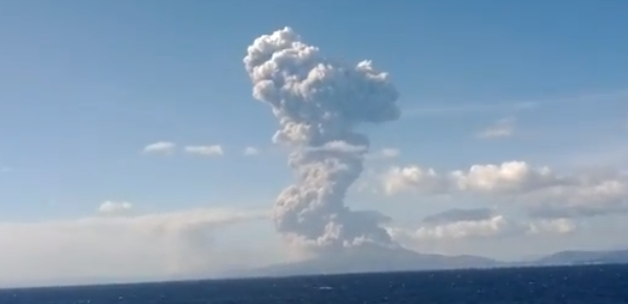Massive eruption at Sakura-jima volcano spewed highest volcanic column in recorded history, Japan

A spectacular eruption of Sakura-jima volcano sent up its highest plume in recorded history on August 18, 2013, the Kagoshima Local Meteorological Observatory said. Massive eruption started at 07:31 UTC (4:31 pm local time) and spewed cascading column of smoke and ash about 5 km above the Showa Crater. This was one of most powerful eruptions of Sakura-jima in decades.

This eruption also marked the 500th eruption since the beginning of 2013.
As seen in the videos below, the sky above the Kagoshima city downtown area became dark and visibility was temporarily deteriorated as large amount of ash fell in the central part of city.




Last entry from GVP database was from the week of August 7 – 13, 2013:
Based on information from JMA, the Tokyo VAAC reported that during August 7 – 11 and August 13 explosions from Sakura-jima generated plumes that rose to altitudes of 1.8-4.6 km (6,000-15,000 ft) a.s.l. and drifted SE, S, and NW. On 8, 10 and 13 August pilots observed ash plumes that rose to altitudes of 2.7-3 km (9,000-10,000 ft) a.s.l., and traveled SE, S, and vertically, respectively. JMA reported that seven explosions at Showa Crater were detected during 9-12 August and ejected tephra as far as 800 m. A 50-minute-long eruption on August 9 generated an ash plume that rose 3.5 km above the crater.


Sakura-jima is a post-caldera cone of the Aira caldera at the northern half of Kagoshima Bay. Eruption of the voluminous Ito pyroclastic flow accompanied formation of the 17 x 23 km wide Aira caldera about 22,000 years ago. The smaller Wakamiko caldera was formed during the early Holocene in the NE corner of the Aira caldera, along with several post-caldera cones.
The construction of Sakura-jima began about 13,000 years ago on the southern rim of Aira caldera and built an island that was finally joined to the Osumi Peninsula during the major explosive and effusive eruption of 1914. Activity at the Kita-dake summit cone ended about 4850 years ago, after which eruptions took place at Minami-dake. Frequent historical eruptions, recorded since the 8th century, have deposited ash on Kagoshima, one of Kyushu's largest cities, located across Kagoshima Bay only 8 km from the summit.
The largest historical eruption took place during 1471-76.
Featured image: YT user Thileepan R video screenshot

There is a good chance the supervolcano in Toba will erupt soon.
All those tiny skyscrapers in the foreground, huge volcano in the background – kind of puts human endeavor into perspective. ^~